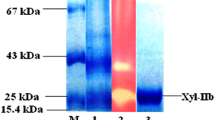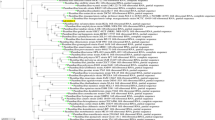Abstract
The gene of endo-beta-1-4 xylanase, xynT, was cloned from Bacillus alcalophilus AX2000 and expressed in Escherichia coli. This XynT, which belongs to glycoside hydrolase (GH) family 10, was found to have a molecular weight of approximately 37 kDa and exhibit optimal activity at pH 7–9 and 50 °C. It exhibits a high activity towards birchwood xylan and has the ability to bind avicel. Under optimal conditions, XynT hydrolyzes all xylooligomers into xylobiose as an end product with a preference for cleavage sites at the second or third glycosidic bond from the reducing end. XynT has a different substrate affinity on xylooligomers at pH 5.0, which contributes to its low activity toward xylotriose and its derived intermediate products. This low activity may be due to an unstable interaction with the amino acids that constitute subsites of the active site. Interestingly, the addition of Co2+ and Mn2+ led to a significant increase in activity by up to 40 and 50 %, respectively. XynT possesses a high binding affinity and hydrolytic activity toward the insoluble xylan, for which it exhibits high activity at pH 7–9, giving rise to its efficient biobleaching effect on Pinus densiflora kraft pulp.






Similar content being viewed by others
References
DE Araujo JHB, DE Moraes FF, Zanin GM (1999) Bleaching of kraft pulp with commercial xylanases. Appl Biochem Biotech 77–79:713–722
Bansod SM, Dutta-Choudhary M, Srinivasan MC, Rele MV (1993) Xylanase active at high pH from an alkalotolerant Cephalosporium species. Biotechnol Lett 15:965–970
Barth P, Alber T, Harbury PB (2007) Accurate, conformation-dependent predictions of solvent effects on protein ionization constants. Proc Natl Acad Sci USA 104:4898–4903
Bissoon S, Christov L, Singh S (2002) Bleach boosting effects of purified xylanase from Thermomyces lanuginosus SSBP on bagasse pulp. Process Biochem 37:567–572
Cao Y, Qiao J, Li Y, Lu W (2007) De novo synthesis, constitutive expression of Aspergillus sulphureus beta-xylanase gene in Pichia pastoris and partical enzymic characterization. Appl Microbiol Biotechnol 76:579–585
Charnock SJ, Spurway TD, Xie H, Beylot MH, Wirden R, Warren RAJ, Hazlewood GP, Gilbert HJ (1998) The topology of the substrate binding clefts of glycosyl hydrolase family 10 xylanases are not conserved. J Biol Chem 273(48):32187–32199
Chandra RK, Chandra TS (1996) Purification and characterization of xylanase from alkali tolerant Aspergillus fischeri FXn1. FEMS Microbiol Lett 145(3):457–461
Collins T, Gerday C, Feller G (2005) Xylanase, xylanase families and extremophilic xylanases. FEMS Microbiol Rev 29:3–23
Damaso MCT, Almeida MS, Kurenbach E, Martins OB, Pereira N, Andrade CMMC, Albano RM (2003) Optimized expression of a thermostable xylanase from Thermomyces lanuginosus in Pichia pastoris. Appl Environ Microbiol 69:6064–6072
Derewenda U, Swenson L, Green R, Wei Y, Morosoli R, Shareck F, Kluepfel D, Derewenda ZS (1994) Crystal structure, 2.6 A resolution, of the Streptomyces lividans xylanase A, a member of the F Family of beta-1,4-D-Glycanases. J Biol Chem 269:20811–20814
Deutscher MP (1990) Guide to protein purification. In: Abelson JA, Simon MI, Colowick SP, Kaplan NO (eds) Methods in enzymology. Academic Press, San Diego, pp 31–38
Duarte MCT, Pellegrino ACA, Portugal EP, Ponezi AN, Franco TT (2000) Characterization of alkaline xylanases from Bacillus pumilus. Braz J Microbiol 31:90–94
Fujimoto Z, Kaneko S, Kuno A, Kobayashi H, Kusakabe I, Mizuno H (2004) Crystal structure of decorated xylooligosaccharides bound to a family 10 xylanase from Streptomyces olivaceoviridis E-86. J Biol Chem 279:9606–9614
Gessesse A (1998) Purification and properties of two thermostable alkaline xylanase from an alkaliphilic Bacillus sp. Appl Environ Microbiol 64:3533–3535
He J, Yu B, Zhang K, Ding X, Chen D (2009) Expression of endo-1, 4-beta-xylanase from Trichoderma reesei in Pichia pastoris and functional characterization of the produced enzyme. BMC Biotechnol 9:1–10
Honda Y, Kitaoka M, Sakka K, Ohmiya K, Hayashi K (2002) An investigation of the pH-activity relationships of Cex, a family 10 xylanase from Cellulomonas fimi: Xylan inhibition and the influence of nitro-substituted aryl-β-D-xylobiosides on xylanase activity. J Biosci Bioengin 93:313–317
Joshi MD, Sidhu G, Pot I, Brayer GD, Withers SG, Mclntosh LP (2000) Hydrogen bonding and catalysis: a novel explanation for how a single amino acid substitution can change the pH optimum of a glycosidase. J Mol Biol 299:255–279
Kui H, Luo H, Shi P, Bai Y, Yuan T, Wang Y, Yang P, Dong S, Yao B (2010) Gene cloning, expression and characterization of a thermostable xylanase from Nesterenkonia xinjiangensis CCTCC AA001025. Appl Biochem Biotechnol 162:953–965
Kulkarni N, Shendye A, Rao M (1999) Molecular and biotechnological aspects of xylanases. FEMS Microbiol Rev 23:411–456
Lee DS, Wi SG, Lee YG, Cho EJ, Chung BY, Bae HJ (2011) Characterization of a new α-L-arabinofuranosidase from Penicillium sp. LYG 0704, and their application in lignocelluloses degradation. Mol Biotechnol 49:229–239
Li XT, Jiang ZQ, Li LT, Yang SQ, Feng WY, Fan JY, Kusakabe I (2005) Characterization of a cellulase-free, neutral xylanase from Thermomyces lanuginosus CBS 288.54 and its biobleaching effect on wheat straw pulp. Bioresour Technol 96:1370–1379
Liu MQ, Weng XY, Sun JY (2006) Expression of recombinant Aspergillus niger xylanase A in Pichia pastoris and its action on xylan. Protein Expr Purif 48:292–299
Liu MQ, Liu FG (2008) Expression of recombinant Bacillus licheniformis xylanase A in Pichia pastoris and xylooligosaccharides released from xylan by it. Protein Expr Purif 57:101–107
Mamo G, Thunnissen M, Hatti-Kaul R, Mattiasson B (2009) An alkaline active xylanase: insights into mechanisms of high pH catalytic adaptation. Biochimie 91:1187–1196
Manikandan K, Bhardwaj A, Gupta N, Kokanath NK, Ghosh A, Reddy VS, Ramakumar S (2006) Crystal structures of native and xylosaccharide-bound alkali thermostable xylanase from an alkalophilic Bacillus sp. NG-27: structural insights into alkalophilicity and implications for adaptation to polyextreme conditions. Protein Sci 15:1951–1960
Mo XC, Chen CL, Pang H, Feng Y, Feng JX (2010) Identification and characterization of a novel xylanase derived from rice straw degrading enrichment culture. Appl Microbiol Biotechnol 87:2137–2146
Nakamura S, Wakabayashi K, Nakai R, Aono R, Horikoshi K (1993) Purification and some properties of an alkaline xylanase from alkaliphilic Bacillus sp. strain 41 M–1. Appl Environ Microbiol 59:2311–2316
Park YS, Kim TY (2003) Isolation of Bacillus alcalophilus AX2000 producing xylanase and its enzyme production. Kor J Microbiol Biotechnol 31:157–164
Park YS (2005) Molecular cloning and nucleotide sequence of xylanase gene (xynT) from Bacillus alcalophilus AX2000. J Life Sci 15:734–738
Pell G, Taylor EJ, Gloster TM, Turkenburg JP, Fontes CMGA, Ferreira LMA, Nagy T, Clark SJ, Davis GJ, Gilbert HJ (2004) The mechanisms by which family 10 glycoside hydrolases bind decorated substrates. J Biol Chem 279:9597–9605
Roberge M, Shareck F, Morosoli R, Kluepfel D, Dupont C (1999) Characterization of active-site aromatic residues in xylanase A from Streptomyces lividans. Protein Eng 12:251–257
Saha BC (2003) Hemicellulose bioconversion. J Ind Microbiol Biotechnol 30:279–291
Schmidt A, Gubitz GM, Kratky C (1999) Xylan binding subsite mapping in the xylanase from Penicillium simplicissimum using xylooligosaccharides as cryo-protectant. Biochemistry 38:2403–2412
Schwarz WH, Bronnenmeier K, Krause B, Lottspeich F, Staudenbauer WI (1995) Debranching of arabinoxylan: properties of the thermoactive recombinant α-L-arabinofuranosidases from Clostridium stercorarium (abfb). Appl Microbiol Biotechnol 43:856–860
Shibuya H, Kaneko S, Hayashi K (2005) A single amino acid substitution enhances the catalytic activity of family 11 xylanase at alkaline pH. Biosci Biotechnol Biochem 69:1492–1497
Subramaniyan S, Prema P (2002) Biotechnology of microbial xylanases: enzymology, molecular biology and application. Crit Rev Biotechnol 22:33–46
Sunna A, Antranikian G (1997) Xylanolytic enzymes from fungi and bacteria. Crit Rev Biotechnol 17:39–67
Tabka MG, Herpoel-Gimbert I, Monod F, Asther M, Sigoillot JC (2006) Enzymatic saccharification of wheat straw for bioethanol production by a combined cellulase xylanase and feruloyl esterase treatment. Enzyme Microb Technol 39:897–902
Teixeira RSS, Siqueira FG, Souza MVD, Filho EXF, Bon EPDS (2010) Purification and characterization studies of a thermostable β-xylanase from Aspergillus awamori. J Ind Microbiol Biotechnol 37:1041–1051
Valls C, Vidal T, Gallardo O, Diaz P, Pastor FIJ, Roncero BR (2010) Obtaining low-HexA-content cellulose from eucalypt fibres: which glycosil hydrolase family is more efficient? Carbohy Polym 80:154–160
Zhang F, Jiu J, Ren WZ, Lin LB, Zhou Y, Zhi XY, Tang SK, Li WJ (2012) Cloning, expression, and characterization of an alkaline thermostable GH11 xylanase from Thermobifida halotolerans YIM 90462T. J Ind Microbiol Biotechnol. doi:10.1007/s10296-012-1119-8
Acknowledgments
This work was supported by the New & Renewable Energy of the Korea Institute of Energy Technology Evaluation and Planning (2010T100100573) grant funded by the Korea government Ministry of Knowledge Economy and by Priority Research Centers Program (2012-0005857), and by WCU (World Class University) project (R31-2009-000-20025-0) through the National Research Foundation of Korea (NRF) funded by the Ministry of Education, Science and Technology to H.-J. Bae.
Author information
Authors and Affiliations
Corresponding author
Rights and permissions
About this article
Cite this article
Lee, DS., Lee, KH., Cho, EJ. et al. Characterization and pH-dependent substrate specificity of alkalophilic xylanase from Bacillus alcalophilus . J Ind Microbiol Biotechnol 39, 1465–1475 (2012). https://doi.org/10.1007/s10295-012-1159-0
Received:
Accepted:
Published:
Issue Date:
DOI: https://doi.org/10.1007/s10295-012-1159-0




